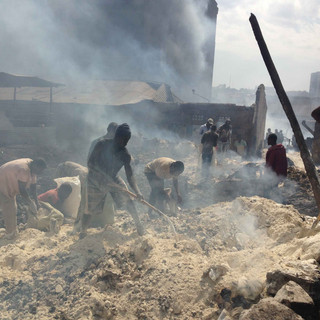Owino Market is on Fire
- topographyoftrade
- Jun 23, 2017
- 3 min read
This morning, I received an urgent call with the news, ‘Owino Market is on Fire’. Having spent time in and around Owino over the last few weeks, I was saddened by this news and concerned about the destruction that this fire would have already caused. I rushed to the market with Robert; on the way there, he mentioned that he had watched the fire outbreak on the news the night before and that the it started on the Kisenyi side of Owino Market. Many questions came to mind: How did the fire start? How far had it spread? What was the damage? Who had been affected by the fire?
For safety purposes, we started by observing the fire from a distance. Viewing out from the third floor of Ham Shopping Centre it became clear that the fire was not actually in Owino Market but coming from Salabed building and a small market area in Kisenyi, right opposite Owino Market. We walked closer to the building and there were hundreds of people watching and/or involved in the aftermath of the fire. Some firemen was spraying water towards the Salabed building which was still letting out a significant amount of smoke. A few men from Umeme (the main electricity provider in Kampala) climbed electric poles around the affected area supposedly cutting off supplies to prevent further damage.
I had read about fires in Kampala's markets before, but seeing the effects of the fire was an experience I will not forget. Thankfully, no one was physically hurt by the fire but the properties that caught fire were badly damaged. Most of the market was built using iron sheets which had been completely burnt to the ground; various people were collecting shrivelled pieces of the iron and other remains from the wreckage. Trucks were then filed with these pieces and this caused a few disputes between conflicting groups fighting for the materials.
This market area was mostly selling maize flour and bags of it were opened and spread across the floor. However, a number of people were digging out the remains and re-packing bags of the flour; I was told that this recycled flour could be sold for animal feed (mostly pigs).
We joined a gathering of people surrounding a 'politician' who was speaking to a news reporter. He was reassuring and comforting victims of the fire, urging them to restart their trading activities.

Cause of the fire
Various different stories were shared between people around the area. Some said that it was caused by a faulty generator, others claimed that it started within one of the iron structures and was an intentional action to destroy the market.
Responses to the fire.
Observing the commotion, an elder lady heard Robert and I discussing the the fire and joined our conversation, she expressed how terrible she felt about the whole situation. She could not understand why anyone would do this to the traders (assuming naturally that it was an intentional fire).
What will happen next?
A small group of traders were complaining that council were stopping any new construction from starting on the site; traders would have to wait for the investigation into the cause of the fire to be completed before they could rebuild their shops.
Previous market fires in Kampala
In the past decade, there have been a number of fires in Kampala's urban markets. Often, these fires start at night (when markets should officially be closed) and the cause of the fires are rarely found.
The Park Yard market was destroyed by fire four times (Mar 2009, July 2011, Nov 2011, Dec 2013) before it was demolished . Owino Market has also been hit by fires in Feb 2009, Aug 2011, April 2013, Feb 2015 and also caught some of the fire from its neighbouring Park Yard market in March 2009. Various other cases have occurred.
It seems important to question and consider whether urban planning and architecture can be used as tools to respond to the ever-rising risk of fire.







Comments